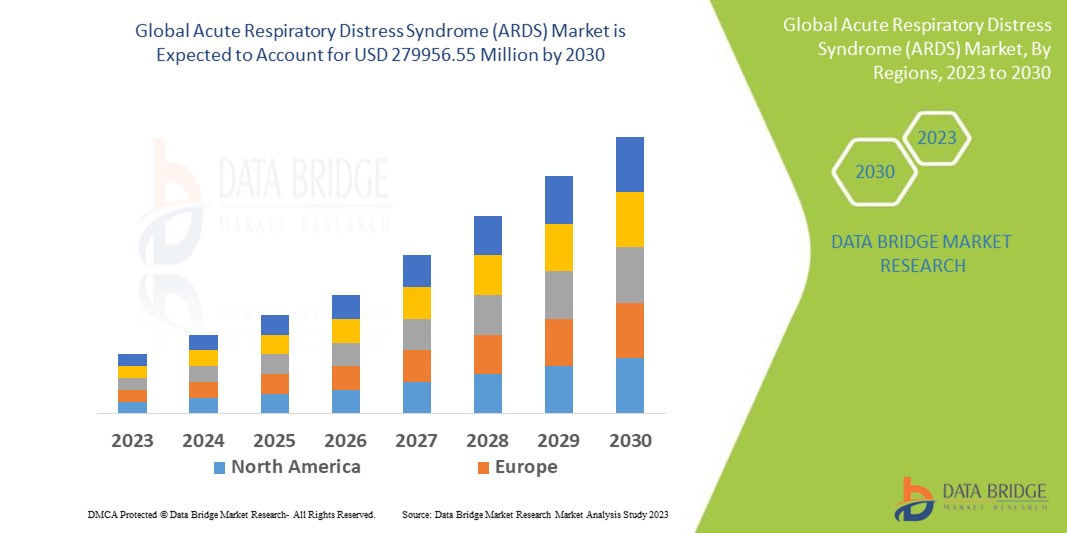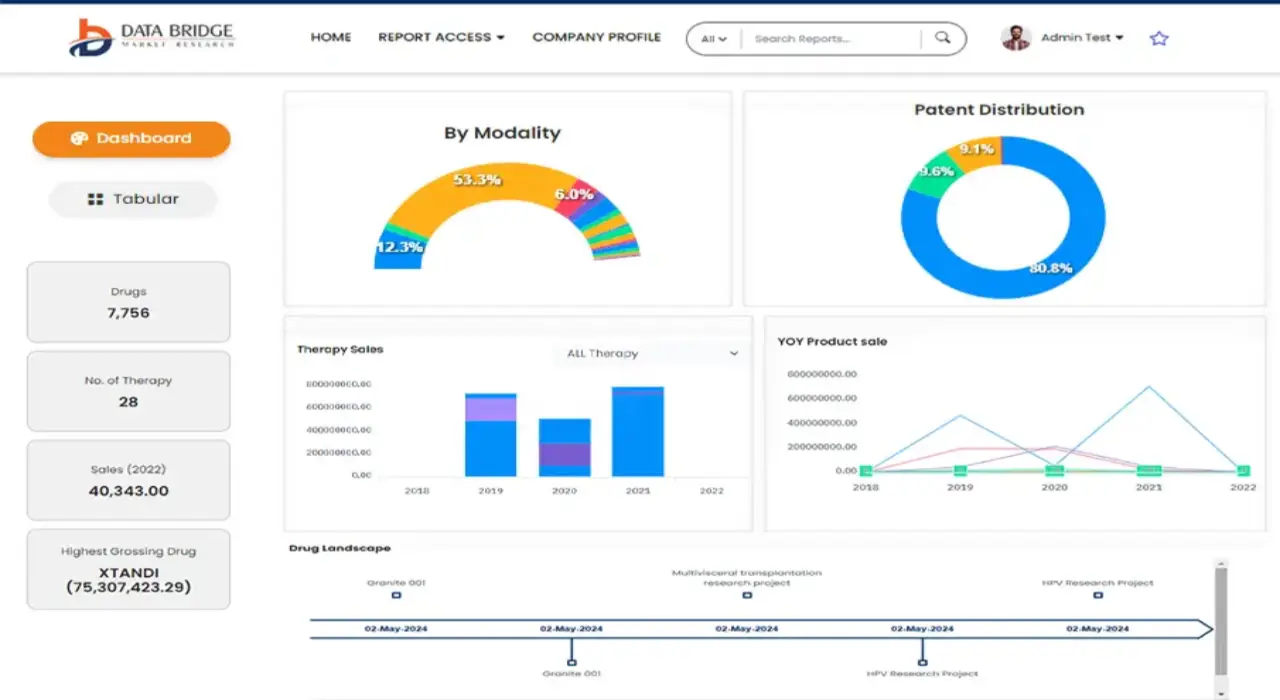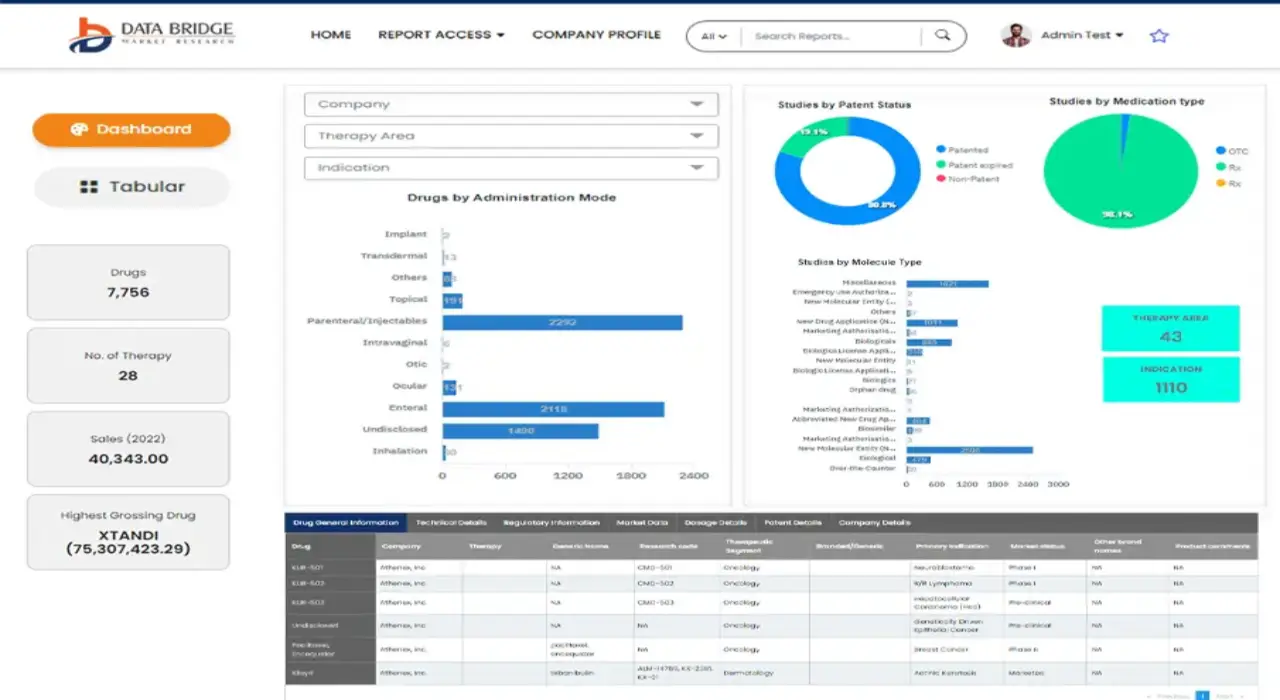Global Acute Respiratory Distress Syndrome Ards Market
Market Size in USD Billion
CAGR :
% 
 USD
339.36 Billion
USD
732.76 Billion
2024
2032
USD
339.36 Billion
USD
732.76 Billion
2024
2032
| 2025 –2032 | |
| USD 339.36 Billion | |
| USD 732.76 Billion | |
|
|
|
|
Global Acute Respiratory Distress Syndrome (ARDS) Market Segmentation, By Cause (Coronavirus Disease 2019 (COVID-19), Sepsis, Inhalation of Harmful Substances, Severe Pneumonia, and Others), Type (Diagnosis and Treatment), Route of Administration (Oral, Parenteral, and Others), End User (Hospitals, Specialty Clinics, Home Healthcare, and Others), Distribution Channel (Direct Tender, Hospital Pharmacy, Retail Pharmacy, Online Pharmacy, and Others) – Industry Trends and Forecast to 2032
Acute Respiratory Distress Syndrome (ARDS) Market Analysis
The acute respiratory distress syndrome (ARDS) market is experiencing significant growth, driven by rising incidences of respiratory disorders, increasing pollution levels, and the growing geriatric population. ARDS, a severe lung condition often caused by infections, pneumonia, or inhalation of harmful substances, requires rapid medical intervention, including ventilatory support and pharmacological treatments. Recent advancements in biotechnology and pharmaceuticals have led to the development of novel therapies, such as regenerative medicine, stem cell-based treatments, and precision-targeted drugs, improving patient outcomes. The market is also benefiting from advancements in non-invasive ventilation techniques and extracorporeal membrane oxygenation (ECMO), which provide better survival rates for critically ill patients. North America dominates the ARDS market due to its strong healthcare infrastructure and access to cutting-edge pharmacological molecules, while Asia-Pacific is witnessing rapid growth due to increased biotechnology research and improving healthcare facilities. Furthermore, the COVID-19 pandemic has heightened awareness about ARDS, accelerating research efforts and increasing government investments in critical care management. The expansion of telemedicine and digital health technologies is also contributing to improved diagnosis and treatment, further driving market growth.
Acute Respiratory Distress Syndrome (ARDS) Market Size
The global acute respiratory distress syndrome (ARDS) market size was valued at USD 339.36 billion in 2024 and is projected to reach USD 732.76 billion by 2032, with a CAGR of 10.10% during the forecast period of 2025 to 2032. In addition to the insights on market scenarios such as market value, growth rate, segmentation, geographical coverage, and major players, the market reports curated by the Data Bridge Market Research also include depth expert analysis, patient epidemiology, pipeline analysis, pricing analysis, and regulatory framework.
Acute Respiratory Distress Syndrome (ARDS) Market Trends
“Growing Adoption of ECMO Therapy”
One significant trend in the acute respiratory distress syndrome (ARDS) market is the growing adoption of extracorporeal membrane oxygenation (ECMO) therapy as an advanced life-support intervention for severe ARDS cases. ECMO provides prolonged cardiac and respiratory support for patients with extreme lung failure when conventional ventilation methods are insufficient. The increasing prevalence of ARDS, particularly in critically ill COVID-19 patients, has accelerated the demand for ECMO systems in intensive care units (ICUs) worldwide. For instance, during the pandemic, leading hospitals in the U.S. and Europe expanded their ECMO programs to improve survival rates for ARDS patients. In addition, advancements in portable ECMO devices have enabled better patient mobility and reduced complications associated with long-term ventilation. With ongoing research into optimizing ECMO protocols and integrating artificial intelligence (AI) for real-time monitoring, the ARDS market is witnessing a shift toward more effective, technology-driven treatment approaches to enhance patient outcomes.
Report Scope and Acute Respiratory Distress Syndrome (ARDS) Market Segmentation
|
Attributes |
Acute Respiratory Distress Syndrome (ARDS) Key Market Insights |
|
Segments Covered |
|
|
Countries Covered |
U.S., Canada and Mexico in North America, Germany, France, U.K., Netherlands, Switzerland, Belgium, Russia, Italy, Spain, Turkey, Rest of Europe in Europe, China, Japan, India, South Korea, Singapore, Malaysia, Australia, Thailand, Indonesia, Philippines, Rest of Asia-Pacific (APAC) in the Asia-Pacific (APAC), Saudi Arabia, U.A.E., South Africa, Egypt, Israel, Rest of Middle East and Africa (MEA) as a part of Middle East and Africa (MEA), Brazil, Argentina and Rest of South America as part of South America |
|
Key Market Players |
F. Hoffmann-La Roche Ltd (Switzerland), Bayer AG (Germany), Sun Pharmaceutical Industries Ltd (India), Novartis AG (Switzerland), Drägerwerk AG & Co. KGaA (Germany), Fisher & Paykel Healthcare Limited (New Zealand), LivaNova PLC (U.K.), Besmed Health Business Corp. (Taiwan), Armstrong Medical (U.K.), Pfizer Inc. (U.S.), WEINMANN Emergency Medical Technology GmbH + Co. KG (Germany), Terumo Medical Corporation (U.S.), Getinge AB. (Sweden), EUROSETS (Italy) |
|
Market Opportunities |
|
|
Value Added Data Infosets |
In addition to the insights on market scenarios such as market value, growth rate, segmentation, geographical coverage, and major players, the market reports curated by the Data Bridge Market Research also include depth expert analysis, patient epidemiology, pipeline analysis, pricing analysis, and regulatory framework. |
Acute Respiratory Distress Syndrome (ARDS) Market Definition
Acute Respiratory Distress Syndrome (ARDS) is a severe and life-threatening condition characterized by rapid-onset respiratory failure due to fluid buildup in the alveoli, leading to impaired oxygen exchange. It is often triggered by underlying conditions such as pneumonia, sepsis, trauma, or inhalation of harmful substances, resulting in widespread inflammation and lung damage.
Acute Respiratory Distress Syndrome (ARDS) Market Dynamics
Drivers
- Rising Incidence of Respiratory Diseases
The increasing prevalence of respiratory diseases such as pneumonia, sepsis, and chronic obstructive pulmonary disease (COPD) has significantly driven the growth of the ARDS market. ARDS often develops as a severe complication of these conditions, necessitating immediate critical care interventions. The COVID-19 pandemic further intensified this trend, with a surge in hospitalizations due to severe respiratory distress. The unprecedented demand for ventilators, oxygen therapy, and pharmaceutical treatments, such as corticosteroids and immunomodulators, demonstrated the urgent need for improved ARDS management. For instance, the widespread adoption of dexamethasone during the pandemic highlighted its efficacy in reducing ARDS-related mortality, reinforcing the importance of continued drug development. This rising disease burden underscores the necessity for enhanced treatment protocols, increased ICU capacity, and further advancements in respiratory support technologies.
- Growing Awareness and Early Diagnosis
Greater awareness among healthcare professionals and the general population regarding ARDS symptoms and early intervention has significantly contributed to market growth. Prompt diagnosis plays a crucial role in reducing complications and improving survival rates, leading to the increased use of advanced imaging techniques, biomarker-based tests, and AI-driven diagnostic tools. For instance, AI-powered chest X-ray analysis has been increasingly implemented to detect early lung deterioration in ARDS patients, allowing for timely and targeted interventions. In addition, medical training programs and awareness campaigns by organizations such as the World Health Organization (WHO) and the Centers for Disease Control and Prevention (CDC) have emphasized the importance of recognizing ARDS symptoms early. As hospitals and ICUs refine their protocols to manage ARDS more effectively, the demand for rapid diagnostic tools, ventilatory support systems, and evidence-based treatment approaches continues to rise, positioning early diagnosis as a key market driver.
Opportunities
- Increasing Technological Advancements in Critical Care
Innovations in mechanical ventilation, extracorporeal membrane oxygenation (ECMO), and non-invasive oxygen delivery systems have significantly improved patient outcomes in ARDS treatment. Traditional ventilation methods, though effective, often led to complications such as ventilator-induced lung injury (VILI). However, the introduction of high-frequency oscillatory ventilation (HFOV) and lung-protective ventilation strategies has reduced mortality rates. In addition, ECMO technology, which provides temporary cardiac and respiratory support, has become a crucial life-saving intervention for severe ARDS patients. For instance, during the COVID-19 pandemic, ECMO utilization surged, demonstrating its critical role in treating acute respiratory failure. Moreover, AI-powered diagnostic imaging and biomarker-based tests have enhanced early detection and personalized treatment plans, leading to better patient outcomes. These technological advancements present a significant market opportunity as hospitals and research institutions increasingly invest in next-generation critical care solutions, driving demand for innovative respiratory support systems and AI-driven diagnostics.
- Increasing Government and Healthcare Investments
Rising healthcare expenditure and government initiatives to strengthen intensive care infrastructure have accelerated advancements in ARDS treatment. Many governments have increased funding for research into novel therapeutics, regenerative medicine, and stem cell therapies, recognizing the urgency of developing more effective interventions. For instance, the U.S. government’s Biomedical Advanced Research and Development Authority (BARDA) has allocated substantial funds for ARDS-related research, supporting innovations in anti-inflammatory drugs and cell-based therapies. Similarly, countries such as Germany and Japan are investing in advanced ICU facilities and expanding healthcare workforce training to enhance ARDS management. These investments are fostering the development of breakthrough treatments such as mesenchymal stem cell therapy, which shows promise in reducing lung inflammation and improving recovery rates. As healthcare policies continue to prioritize critical care advancements, pharmaceutical companies, biotech firms, and medical device manufacturers stand to benefit from the growing demand for cutting-edge ARDS therapies and equipment, solidifying this trend as a key market opportunity.
Restraints/Challenges
- High Treatment Costs and ICU Burden
The management of ARDS requires intensive care, prolonged hospital stays, and advanced respiratory support, leading to high treatment costs. Patients often need ventilators, extracorporeal membrane oxygenation (ECMO), and specialized drugs, which can be expensive. In the U.S., the average cost of ARDS hospitalization exceeds more than half a million dollar per patient, making it financially burdensome for healthcare systems and patients. These high costs restrict access to treatment in low- and middle-income countries (LMICs), widening healthcare disparities.
- Challenges in Early Diagnosis & Disease Progression
ARDS is often underdiagnosed or diagnosed too late, as its symptoms—such as shortness of breath, low oxygen levels, and lung inflammation—overlap with other respiratory conditions such as pneumonia and COVID-19. The lack of reliable biomarkers and rapid diagnostic tools makes early detection difficult, leading to delayed treatment and worse patient outcomes. For instance, by the time ARDS is diagnosed, many patients have already developed severe lung damage, limiting treatment effectiveness.
This market report provides details of new recent developments, trade regulations, import-export analysis, production analysis, value chain optimization, market share, impact of domestic and localized market players, analyses opportunities in terms of emerging revenue pockets, changes in market regulations, strategic market growth analysis, market size, category market growths, application niches and dominance, product approvals, product launches, geographic expansions, technological innovations in the market. To gain more info on the market contact Data Bridge Market Research for an Analyst Brief, our team will help you take an informed market decision to achieve market growth.
Acute Respiratory Distress Syndrome (ARDS) Market Scope
The market is segmented on the basis of cause, type, route of administration, end user, and distribution channel. The growth amongst these segments will help you analyse meagre growth segments in the industries and provide the users with a valuable market overview and market insights to help them make strategic decisions for identifying core market applications.
Cause
- Coronavirus Disease 2019 (COVID-19)
- Sepsis
- Inhalation of Harmful Substances
- Severe Pneumonia
- Others
Type
- Diagnosis
- Treatment
Route of Administration
- Oral
- Parenteral
- Others
End User
- Hospitals
- Specialty Clinics
- Home Healthcare
- Others
Distribution Channel
- Direct Tender
- Hospital Pharmacy
- Retail Pharmacy
- Online Pharmacy
- Others
Acute Respiratory Distress Syndrome (ARDS) Market Regional Analysis
The market is analysed and market size insights and trends are provided by country, cause, type, route of administration, end user, and distribution channel as referenced above.
The countries covered in the market report are U.S., Canada and Mexico in North America, Germany, France, U.K., Netherlands, Switzerland, Belgium, Russia, Italy, Spain, Turkey, Rest of Europe in Europe, China, Japan, India, South Korea, Singapore, Malaysia, Australia, Thailand, Indonesia, Philippines, Rest of Asia-Pacific (APAC) in the Asia-Pacific (APAC), Saudi Arabia, U.A.E., South Africa, Egypt, Israel, Rest of Middle East and Africa (MEA) as a part of Middle East and Africa (MEA), Brazil, Argentina and Rest of South America as part of South America.
North America holds a dominant position in the acute respiratory distress syndrome (ARDS) market due to continuous technological advancements in treatment methods and respiratory support systems. The region benefits from the presence of numerous innovative pharmacological molecules designed to enhance therapeutic outcomes and improve patient recovery rates. In addition, a well-established healthcare infrastructure, coupled with significant investments in research and development, further drives market growth. The availability of advanced medical facilities and strong regulatory support also contribute to the widespread adoption of cutting-edge ARDS treatments in North America.
Asia-Pacific is projected to experience the highest growth rate in the acute respiratory distress syndrome (ARDS) market from 2025 to 2032, driven by a surge in biotechnology research and development activities. The region is witnessing increased investments in medical innovation, fostering advancements in respiratory therapies and drug development. In addition, the rising prevalence of respiratory diseases, along with government initiatives to strengthen healthcare infrastructure, is further accelerating market expansion. The growing presence of research centers and pharmaceutical companies is also contributing to the rapid adoption of advanced ARDS treatment solutions in the region.
The country section of the report also provides individual market impacting factors and changes in regulation in the market domestically that impacts the current and future trends of the market. Data points such as down-stream and upstream value chain analysis, technical trends and porter's five forces analysis, case studies are some of the pointers used to forecast the market scenario for individual countries. Also, the presence and availability of global brands and their challenges faced due to large or scarce competition from local and domestic brands, impact of domestic tariffs and trade routes are considered while providing forecast analysis of the country data.
Acute Respiratory Distress Syndrome (ARDS) Market Share
The market competitive landscape provides details by competitor. Details included are company overview, company financials, revenue generated, market potential, investment in research and development, new market initiatives, global presence, production sites and facilities, production capacities, company strengths and weaknesses, product launch, product width and breadth, application dominance. The above data points provided are only related to the companies' focus related to market.
Acute Respiratory Distress Syndrome (ARDS) Market Leaders Operating in the Market Are:
- F. Hoffmann-La Roche Ltd (Switzerland)
- Bayer AG (Germany)
- Sun Pharmaceutical Industries Ltd (India)
- Novartis AG (Switzerland)
- Drägerwerk AG & Co. KGaA (Germany)
- Fisher & Paykel Healthcare Limited (New Zealand)
- LivaNova PLC (U.K.)
- Besmed Health Business Corp. (Taiwan)
- Armstrong Medical (U.K.)
- Pfizer Inc. (U.S.)
- WEINMANN Emergency Medical Technology GmbH + Co. KG (Germany)
- Terumo Medical Corporation (U.S.)
- Getinge AB. (Sweden)
- EUROSETS (Italy)
Latest Developments in Acute Respiratory Distress Syndrome (ARDS) Market
- In October 2023, GEn1E Lifesciences Inc. announced that it had secured a contract from the United States Department of Health and Human Services, Biomedical Advanced Research and Development Authority (BARDA), to support the development of its novel therapy, GEn-1124, aimed at treating acute respiratory distress syndrome (ARDS)
- In April 2023, Direct Biologics announced that the U.S. FDA had approved the expansion of its pivotal Phase 3 EXTINGUISH ARDS trial to evaluate the safety and efficacy of ExoFlo for the treatment of moderate-to-severe ARDS caused by various underlying conditions
- In April 2022, the Food and Drug Administration (FDA) granted approval to Direct Biologics to proceed with a landmark Phase 3 clinical trial using its investigational EV drug, ExoFlo, for the treatment of acute respiratory distress syndrome (ARDS)
- In January 2022, Veru announced that its drug Sabizabulin had received a fast-track designation from the FDA for the treatment of hospitalized COVID-19 patients at high risk of developing acute respiratory distress syndrome (ARDS)
- In January 2021, Fisher & Paykel Healthcare Limited launched its innovative Optiflow+ nasal high-flow therapy system, designed to provide respiratory support for patients suffering from ARDS and other respiratory conditions
SKU-
Get online access to the report on the World's First Market Intelligence Cloud
- Interactive Data Analysis Dashboard
- Company Analysis Dashboard for high growth potential opportunities
- Research Analyst Access for customization & queries
- Competitor Analysis with Interactive dashboard
- Latest News, Updates & Trend analysis
- Harness the Power of Benchmark Analysis for Comprehensive Competitor Tracking
Research Methodology
Data collection and base year analysis are done using data collection modules with large sample sizes. The stage includes obtaining market information or related data through various sources and strategies. It includes examining and planning all the data acquired from the past in advance. It likewise envelops the examination of information inconsistencies seen across different information sources. The market data is analysed and estimated using market statistical and coherent models. Also, market share analysis and key trend analysis are the major success factors in the market report. To know more, please request an analyst call or drop down your inquiry.
The key research methodology used by DBMR research team is data triangulation which involves data mining, analysis of the impact of data variables on the market and primary (industry expert) validation. Data models include Vendor Positioning Grid, Market Time Line Analysis, Market Overview and Guide, Company Positioning Grid, Patent Analysis, Pricing Analysis, Company Market Share Analysis, Standards of Measurement, Global versus Regional and Vendor Share Analysis. To know more about the research methodology, drop in an inquiry to speak to our industry experts.
Customization Available
Data Bridge Market Research is a leader in advanced formative research. We take pride in servicing our existing and new customers with data and analysis that match and suits their goal. The report can be customized to include price trend analysis of target brands understanding the market for additional countries (ask for the list of countries), clinical trial results data, literature review, refurbished market and product base analysis. Market analysis of target competitors can be analyzed from technology-based analysis to market portfolio strategies. We can add as many competitors that you require data about in the format and data style you are looking for. Our team of analysts can also provide you data in crude raw excel files pivot tables (Fact book) or can assist you in creating presentations from the data sets available in the report.













